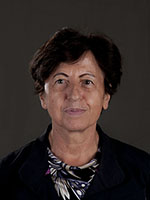1st Keynote Speaker

Prof. Bhavani Thuraisingham
The University of Texas at Dallas, USA
Title: SecAI: Integrating Cyber Security and Artificial Intelligence
Abstract: Artificial Intelligence (AI) emerged as a field of study in Computer Science in the late 1950s. Researchers were interested in designing and developing systems that could behave like humans. This interest resulted in substantial developments in areas such as expert systems, machine learning, planning systems, reasoning systems and robotics. However, it is only recently that these AI systems are being used in practical applications in various fields such as medicine, finance, marketing, defense, and manufacturing. The main reason behind the success of these AI systems is due to the developments in data science and high-performance computing. For example, it is now possible collect, store, manipulate, analyze and retain massive amounts of data and therefore the AI systems are now able to learn patterns from this data and make useful predictions.
While AI has been evolving as a field during the past sixty years, the developments in computing systems and data management systems have resulted in serious security and privacy considerations. Various regulations are being proposed to handle big data so that the privacy of the individuals is not violated. For example, even if personally identifiable information is removed from the data, when data is combined with other data, an individual can be identified. Furthermore, the computing systems are being attacked by malware resulting in disastrous consequences. In order words, as progress is being made with technology, the security of these technologies is in serious question due to the malicious attacks.
Over the decade. AI and Security are being integrated. For example, machine learning techniques are being applied to solve security problems such as malware analysis, intrusion detection and insider threat detection. However, there is also a major concern that the machine learning techniques themselves could be attacked. Therefore, the machine leading techniques are being adapted to handle adversarial attacks. This area is known as adversarial machine learning. Furthermore, while collecting massive amounts of data causes security and privacy concerns, big data analytics applications in cyber security is exploding. For example, an organization can outsource activities such as identity management, intrusion detection and malware analysis to the cloud. While AI techniques are being applied to solve cyber security problems, the AI systems have to be protected. For example, how can the machine learning systems be protected from the attacks? What are the threats to the planning systems? How can expert system carry out their functions in the midst of malware attacks? What are the appropriate access control models for AI systems? How can we develop appropriate security policies for AI systems? These are questions that researchers are beginning to provide answers to.
To assess the developments on the integration of AI and Security over the past decade and to determine future directions, the presentation will focus on two major questions: (i) how can the developments in AI techniques be used to solve security problems and (ii) how can we ensure that the AI systems are secure and(iii) what are the security and privacy considerations for AI systems. Second, it will describe the application of AI including machine learning for cyber security applications such as insider threat detection. Third, it will discuss the trends in areas such as adversarial machine learning that take into consideration the attacker’s behavior in developing machine learning techniques. Fourth, it will discuss some emerging trends in carrying out trustworthy AI so that the AI techniques can be secured against malicious attacks. Fifth, it will focus on the privacy threats due to the collection of massive amounts of data and potential solutions. Finally, it will discuss the next steps.
Bio:Dr. Bhavani Thuraisingham is the Founders Chaired Professor of Computer Science and the Executive Director of the Cyber Security Research and Education Institute at the University of Texas at Dallas. She is also a visiting Senior Research Fellow at Kings College, University of London and a Fellow of the ACM, IEEE, the AAAS, the NAI and the BCS. She has received several awards including the IEEE CS 1997 Technical Achievement Award, ACM SIGSAC 2010 Outstanding Contributions Award, and the ACM SACMAT 10 Year Test of Time Awards for 2018 and2019. She co-chaired the Women in Cyber Security Conference (WiCyS) in 2016 and delivered the featured address at the 2018 Women in Data Science (WiDS) at Stanford University and has chaired several conferences for ACM and IEEE. Her 39 years career included industry (Honeywell), federal laboratory (MITRE), US government (NSF) and US Academia. Her work has resulted in 130+ journal articles, 300+ conference papers, 140+ keynote and featured addresses, six US patents, fifteen books as well as technology transfer of the research to commercial and operational systems. She received her PhD from the University of Wales, Swansea, UK, and the prestigious earned higher doctorate (D. Eng) from the University of Bristol, UK.
2nd Keynote Speaker

Prof. Elisa Bertino
Purdue University, USA
Title: Data Security and Privacy in the IoT
Abstract: The Internet of Things (IoT) paradigm refers to the network of physical objects or "things" embedded with electronics, software, sensors, and connectivity to enable objects to exchange data with servers, centralized systems, and/or other connected devices based on a variety of communication infrastructures. IoT makes it possible to sense and control objects creating opportunities for more direct integration between the physical world and computer-based systems. IoT will usher automation in a large number of application domains, ranging from manufacturing and energy management (e.g. SmartGrid), to healthcare management and urban life (e.g. SmartCity). However, because of its fine-grained, continuous and pervasive data acquisition and control capabilities, IoT raises concerns about data security and privacy. Deploying existing security solutions to IoT is not straightforward because of device heterogeneity, highly dynamic and possibly unprotected environments, and large scale. In this talk, after outlining key challenges in IoT data security and privacy, we present initial approaches to securing IoT data, including recent edge-based security solutions for IoT security and analysis of cellular network protocols.
Bio: Elisa Bertino is professor of Computer Science at Purdue University. Prior to joining Purdue, she was a professor and department head at the Department of Computer Science and Communication of the University of Milan. She has been a visiting researcher at the IBM Research Laboratory (now Almaden) in San Jose, at the Microelectronics and Computer Technology Corporation, at Rutgers University, at Telcordia Technologies. Her main research interests include security, privacy, database systems, distributed systems, and sensor networks. Her recent research focuses on digital identity management, biometrics, IoT security, security of 4G and 5G cellular network protocols, and policy infrastructures for managing distributed systems. Prof. Bertino has published more than 700 papers in all major refereed journals, and in proceedings of international conferences and symposia. She has given keynotes, tutorials and invited presentations at conferences and other events. She is a Fellow member of ACM, IEEE, and AAAS. She received the 2002 IEEE Computer Society Technical Achievement Award for "For outstanding contributions to database systems and database security and advanced data management systems" and the 2005 IEEE Computer Society Tsutomu Kanai Award for “Pioneering and innovative research contributions to secure distributed systems”. She received the ACM Athena Lecturer Award in 2019.
3rd Keynote Speaker

Prof. Witold Pedrycz
University of Alberta, Canada
Title: Explainable AI: From Data to Symbols and Information Granules
Abstract: With the progress and omnipresence of Artificial Intelligence (AI), two aspects of this discipline become more apparent. When tackling some important societal underpinnings, especially those encountered in strategic areas, AI constructs call for tangible interpretability and explainability capabilities. Some of the recent advancements in AI fall under the umbrella of industrial developments (which are predominantly driven by numeric data). With the vast amounts of data, one needs to resort herself to engaging abstract entities in order to cope with complexity of the real-world problems and deliver transparency of the required solutions. All of those factors give rise to a recently pursued discipline of explainable AI (XAI). From the dawn of AI, symbols and ensuing symbolic processing have assumed a central position and ways of symbol grounding become of paramount interest. We advocate that in the realization of the timely pursuits of XAI, information granules and Granular Computing (embracing fuzzy sets, rough sets, intervals, among others) play a significant role. The two profound features that facilitate explanation and interpretation are about an accommodation of the logic fabric of constructs, a selection of a suitable level of abstraction and modularity and splitting complex problems into a collection of subproblems. They go hand-in-hand with information granules. First, it is demonstrated that information granularity is of paramount relevance in building linkages between real-world data and symbols encountered in AI processing. Second, we stress that a suitable level of abstraction (specificity of information granularity) becomes essential to support user-oriented framework of design and functioning AI artifacts. In both cases, central to all pursuits is a process of formation of information granules and their prudent characterization. We discuss a comprehensive approach to the development of information granules by means of the principle of justifiable granularity and its generalized versions. Here various construction scenarios are discussed including those engaging conditioning and collaborative mechanisms in the design of information granules. The mechanisms of assessing the quality of granules are presented. We look at the generative and discriminative aspects of information granules supporting their further diversified usage in the AI constructs. A symbolic manifestation of information granules is put forward and analyzed from the perspective of semantically sound descriptors of data and relationships among data. With this regard, selected aspects of stability and summarization of symbol- oriented information are revealed.
Bio: Witold Pedrycz (IEEE Fellow, 1998) is Professor and Canada Research Chair (CRC) in Computational Intelligence in the Department of Electrical and Computer Engineering, University of Alberta, Edmonton, Canada. He is also with the Systems Research Institute of the Polish Academy of Sciences, Warsaw, Poland. In 2009 Dr. Pedrycz was elected a foreign member of the Polish Academy of Sciences. In 2012 he was elected a Fellow of the Royal Society of Canada. In 2007 he received a prestigious Norbert Wiener award from the IEEE Systems, Man, and Cybernetics Society. He is a recipient of the IEEE Canada Computer Engineering Medal, a Cajastur Prize for Soft Computing from the European Centre for Soft Computing, a Killam Prize, a Fuzzy Pioneer Award from the IEEE Computational Intelligence Society, and 2019 Meritorious Service Award from the IEEE Systems Man and Cybernetics Society. His main research directions involve Computational Intelligence, fuzzy modeling and Granular Computing, knowledge discovery and data science, pattern recognition, data science, knowledge-based neural networks, and control engineering. He has published numerous papers in these areas; the current h-index is 111 (Google Scholar) and 82 on the list top-h scientists for computer science and electronics http://www.guide2research.com/scientists/. He is also an author of 21 research monographs and edited volumes covering various aspects of Computational Intelligence, data mining, and Software Engineering. Dr. Pedrycz is vigorously involved in editorial activities. He is an Editor-in-Chief of Information Sciences, Editor-in-Chief of WIREs Data Mining and Knowledge Discovery (Wiley), and Co-editor-in-Chief of Int. J. of Granular Computing (Springer) and J. of Data Information and Management (Springer). He serves on an Advisory Board of IEEE Transactions on Fuzzy Systems and is a member of a number of editorial boards of international journals.
4th Keynote Speaker

Prof. Robert Kozma
University of Memphis, USA
Title: Sustainable Artificial Intelligence
Abstract: The development of increasingly powerful computing devices has been dominated by Moore's law for over half a century, which may reach an end soon demanding a drastic reformulation of existing approaches to computing. A key issue is the massive energy utilization by the electronics components and the consequent dissipation of the energy in the form of heat. Energy constraints are often ignored or have just secondary role in typical cutting-edge AI approaches. For example, Deep Learning Neural Networks often require huge amount of data/ time/ parameters/ energy/ computational power, which may not be readily available in various scenarios, such as edge computing and on-board applications. Human brains are very efficient devices using 20W power, which is many orders of magnitudes less than the power consumption of today’s supercomputers requiring MWs to innovatively solve a given machine learning task. Brain waves and spatio-temporal oscillations implement pattern-based computing principles. Analyzing brain oscillations and metabolism can help to develop computational and hardware implementations, which are energy-efficient and provide a path towards sustainable AI. Among the various potential solutions for sustainable AI, neuromorphic computing and chip designs gained prominence in recent years. Popular crossbar architectures are especially well suited for pattern-based computing, with the potential of complementing the sequential symbol manipulation paradigm of traditional Turing machines. Applications include autonomous on-board signal processing and control, distributed sensor systems, autonomous robot navigation and control, and rapid response to emergencies.
Bio: Dr. Robert Kozma (Fellow IEEE; Fellow INNS) holds a Ph.D. in Applied Physics (Delft, The Netherlands), two M.Sc. degrees (Mathematics, Hungary; and Power Engineering, Moscow MEI, Russia). He is Professor of Mathematics, funding Director of Center for Large-Scale Intelligent Optimization and Networks (CLION), FedEx Institute of Technology, University of Memphis, TN. He has been Visiting Professor of Computer Science, University of Massachusetts Amherst since 2016. Previous assignments include US Air Force Research Laboratory, Sensors Directorate; NASA Jet Propulsion Laboratory, Robotics Division; University of California at Berkeley, EECS and Division of Neurobiology; Otago University, Information Sciences, New Zealand; Tohoku University, Quantum Science and Engineering, Japan. He has over 30 years of experience in intelligent signal processing, large-scale networks and graph theory, distributed sensor systems, biomedical domains, including brain dynamics. He has 7 book volumes, over 300 articles in journals and proceedings, and 3 patent disclosures. Research funding by agencies NASA, DARPA, AFRL, AFOSR, NSF, and others. He is Editor-In-Chief of IEEE Transactions on Systems, Man, and Cybernetics - Systems, and serves on the Editorial Boards on several journals. He serves on the Governing Board of IEEE Systems, Man, and Cybernetics Society, and previously served on the AdCom of the IEEE Computational Intelligence Society. He is past President of the International Neural Networks Society (INNS), recipient of the Denis Gabor Award of INNS. He has been General Chair of the International Joint Conference on Neural Networks, IJCNN2009, and has been Program Chair/Co-Chair and TC member of several dozens of international conferences.




